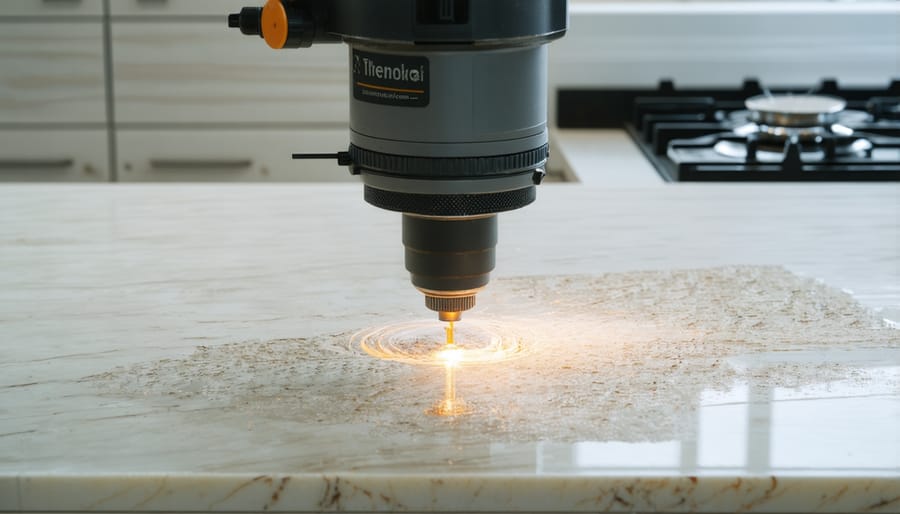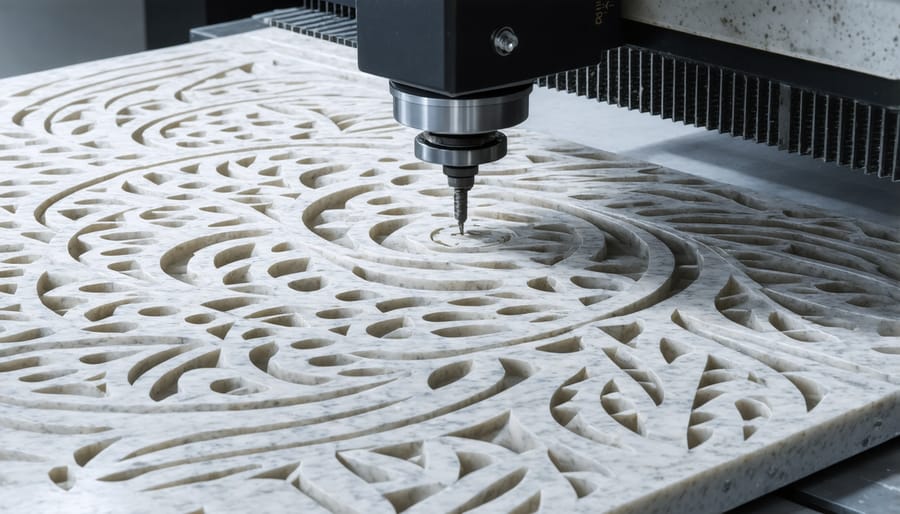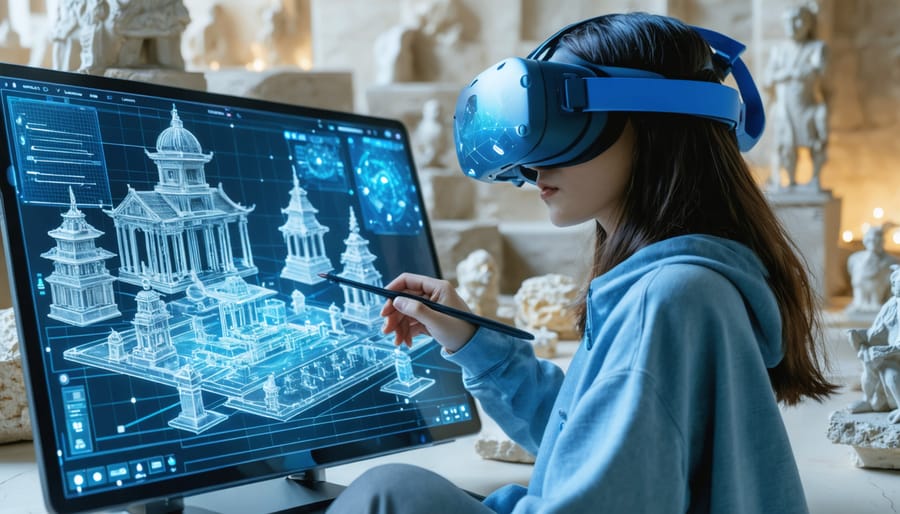The revolution of digital stone technology has transformed the landscape of modern stone design, empowering professionals with unprecedented precision and creative possibilities. From sophisticated 3D modeling software to automated fabrication systems, today’s technological resources are reshaping how we conceptualize, design, and execute stone projects. These innovative tools not only streamline workflows but also unlock new artistic potential, allowing designers and fabricators to push the boundaries of what’s possible with natural stone.
The convergence of traditional craftsmanship with cutting-edge technology has created a new paradigm in stone design, where ancient materials meet modern methods. Whether you’re an architect envisioning a bold architectural statement or a fabricator seeking to optimize production efficiency, understanding these seven technological resources is crucial for staying competitive in today’s market. These tools represent the forefront of industry innovation, offering solutions that enhance creativity, improve accuracy, reduce waste, and deliver superior results for even the most demanding projects.
Let’s explore the game-changing technologies that are defining the future of stone design and fabrication.
3D Modeling and Visualization Software
CAD Programs for Stone Design
Modern CAD programs have revolutionized stone design, enabling architects and designers to create groundbreaking marble masterpieces with unprecedented precision. Industry-standard software like StoneCAD, AutoCAD Stone, and Pegasus offer specialized tools for stone-specific applications, allowing designers to visualize complex patterns, calculate material requirements, and generate detailed fabrication instructions.
These programs feature stone-specific libraries containing thousands of textures and patterns, enabling realistic 3D rendering of different stone types. Advanced features include automatic nesting for optimal material usage, joint planning tools for seamless installations, and built-in estimation capabilities for accurate project costing.
Cloud-based solutions have made collaboration easier, allowing teams to work simultaneously on projects while maintaining version control. Many programs now integrate with CNC machinery, creating a seamless workflow from design to fabrication. Mobile compatibility enables on-site modifications and real-time project updates, making these tools invaluable for modern stone design professionals.
The learning curve varies by program, but most manufacturers offer comprehensive training resources and technical support to help users maximize their software’s potential.
Virtual Reality Design Tools
Virtual reality has revolutionized how we visualize and present stone designs, offering immersive experiences that bring concepts to life before any physical work begins. Modern VR tools allow designers and clients to walk through virtual spaces, examining stone patterns, textures, and installations from every angle.
Applications like Enscape and Lumion integrate seamlessly with popular CAD software, enabling real-time rendering of stone surfaces with photorealistic quality. These tools simulate natural lighting conditions and environmental factors, showing how different stone materials will appear throughout the day.
For client presentations, VR platforms like Prospect by IrisVR enable collaborative virtual walkthroughs, where stakeholders can explore design options and make informed decisions about stone selections. Users can switch between material options instantly, comparing various stone types and finishes in the intended space.
The technology also helps identify potential installation challenges early in the design phase. Designers can examine complex stone patterns, verify joint alignments, and evaluate the visual impact of different laying patterns before committing to final decisions. This capability significantly reduces costly modifications during construction and ensures client satisfaction with the end result.

Digital Templating Systems
Laser Measuring Devices
Laser measuring devices have revolutionized the natural stone industry by providing unprecedented accuracy and efficiency in measurement tasks. These high-precision tools use laser technology to capture exact dimensions, eliminating the margin of error common with traditional measuring methods. Modern laser devices can measure distances up to 150 feet with accuracy within 1/16 of an inch, making them invaluable for both initial site surveys and final installation verification.
These tools offer multiple measurement modes, including length, area, and volume calculations, which are particularly useful when estimating material requirements for complex stone projects. Many models feature Bluetooth connectivity, allowing measurements to be directly transferred to design software or mobile devices. This seamless integration helps prevent transcription errors and streamlines the documentation process.
Advanced features like built-in inclinometers and pythagoras functions enable professionals to measure difficult-to-reach areas or calculate heights indirectly. The ability to store measurements and create digital records also provides better project documentation and helps maintain accountability throughout the stone fabrication and installation process.
For professionals working with natural stone, laser measuring devices represent a critical investment that pays dividends in improved accuracy, reduced material waste, and increased project efficiency.

Photogrammetry Solutions
Photogrammetry has revolutionized digital templating in the stone industry by enabling precise measurements through photographs. This technology allows professionals to capture detailed spatial data of installation sites using standard digital cameras or smartphones equipped with specialized apps. By taking multiple overlapping photos from different angles, the software creates accurate 3D models and measurements of the space.
The process significantly reduces the time spent on-site while minimizing measurement errors. Fabricators can generate precise templates for complex countertops, wall cladding, and other stone applications without traditional physical templating methods. This digital approach particularly shines in challenging spaces with irregular shapes or difficult access.
Modern photogrammetry solutions often integrate with CAD software, creating a seamless workflow from measurement to fabrication. The technology also maintains detailed project documentation, allowing teams to reference exact measurements and specifications throughout the project lifecycle. For renovation projects, this capability proves invaluable when working with existing structures and ensuring perfect fits for new stone installations.
CNC Fabrication Technology
Modern CNC Machines
Modern CNC (Computer Numerical Control) machines have revolutionized stone fabrication, offering unprecedented precision and efficiency in creating complex designs. These sophisticated machines use advanced computer programming to control cutting tools, delivering consistent results with minimal waste. Five-axis CNC machines, the current industry standard, can execute intricate cuts from multiple angles, enabling the creation of detailed patterns, textures, and three-dimensional features in stone surfaces.
Today’s CNC technology incorporates digital templating and automated tool changing systems, significantly reducing production time while maintaining exceptional quality. These machines can handle various stone materials, from granite and marble to engineered stone, with specialized tools for each material type. Advanced features like automatic edge profiling, waterjet cutting capabilities, and integrated vacuum systems ensure clean, precise cuts while protecting the stone’s integrity.
The latest CNC machines also include real-time monitoring systems, allowing operators to track progress and make adjustments during fabrication. This technology enables fabricators to produce complex architectural elements, custom countertops, and artistic installations with remarkable accuracy and consistency, meeting the growing demand for sophisticated stone designs in modern architecture.

Software Integration
Modern stone fabrication relies heavily on sophisticated software integration systems that bridge the gap between design and production. Computer-Aided Manufacturing (CAM) software transforms digital designs into machine-readable instructions, enabling precise cutting and finishing operations. These systems communicate directly with CNC machines, ensuring exact replication of complex patterns and customized designs.
Machine control systems serve as the operational backbone, monitoring and adjusting parameters like cutting speed, water pressure, and tool rotation in real-time. Advanced interfaces allow operators to track multiple production lines simultaneously, optimizing workflow efficiency and reducing material waste.
Integration platforms now offer cloud connectivity, enabling remote monitoring and troubleshooting capabilities. This feature proves particularly valuable for large-scale operations where multiple fabrication centers need to maintain consistent quality standards. The software also maintains detailed production logs, facilitating quality control and providing valuable data for process improvement.
Many systems now include automated nesting capabilities, maximizing material utilization by optimally arranging cuts on stone slabs. This smart resource allocation, combined with predictive maintenance alerts, helps fabricators maintain high productivity while reducing operational costs.
Quality Control Technologies
Quality control in stone fabrication has evolved significantly with the integration of advanced technological solutions. Digital measurement systems, such as laser scanners and coordinate measuring machines (CMMs), ensure precise dimensional accuracy throughout the fabrication process. These tools can detect variations as small as 0.1mm, guaranteeing exceptional consistency in stone products.
Modern quality control software platforms integrate with these measurement tools to provide real-time monitoring and documentation. They track critical parameters like material thickness, surface finish, and structural integrity, helping fabricators maintain strict quality standards while improving efficiency.
Surface analysis technology has become increasingly sophisticated, utilizing high-resolution cameras and specialized lighting systems to detect imperfections invisible to the naked eye. These systems can identify subtle variations in color, texture, and pattern, ensuring aesthetic consistency across large stone installations.
Digital moisture meters and porosity testing equipment help fabricators assess material properties crucial for proper installation and longevity. This data helps determine appropriate modern stone resurfacing techniques and maintenance requirements.
Advanced quality control systems also incorporate artificial intelligence to predict potential issues before they occur. By analyzing patterns in production data, these systems can recommend preventive measures, reducing waste and improving overall product quality. This predictive capability, combined with automated documentation and reporting features, helps fabricators maintain comprehensive quality records while streamlining their certification processes.
Project Management Software
Modern project management software has revolutionized how stone design and installation projects are executed, offering comprehensive solutions that streamline workflows and enhance collaboration. These specialized platforms help teams track every aspect of stone projects, from initial design concepts to final installation.
Industry-specific software like StoneCloud, Moraware, and JobTracker allows project managers to coordinate multiple tasks, monitor deadlines, and manage resources efficiently. These tools typically include features for managing stone inventory, creating detailed project timelines, and tracking material costs. Digital templates help standardize processes, reducing errors and ensuring consistent quality across projects.
Cloud-based solutions enable real-time collaboration between designers, fabricators, and installers, regardless of their location. Team members can access project details, share updates, and communicate changes instantly, minimizing delays and miscommunication. Many platforms also integrate with CAD software and digital measuring tools, creating a seamless workflow from design to fabrication.
Project management software often includes customer relationship management (CRM) features, helping businesses maintain detailed client histories, track communications, and manage approvals. Advanced scheduling capabilities ensure optimal resource allocation and help prevent bottlenecks in production and installation phases.
Financial tracking features allow managers to monitor budgets, generate quotes, and track expenses in real-time. Some systems even offer predictive analytics, helping companies forecast material needs and optimize inventory levels. Mobile accessibility ensures that field teams can update project status and access critical information while on-site, improving efficiency and reducing administrative overhead.
Mobile Applications
Mobile applications have revolutionized how stone professionals interact with clients and manage projects in the field. Several essential apps stand out for their practical applications in the stone industry.
For visualization and design, the Stones App allows professionals to showcase different stone varieties to clients in real-time, complete with texture mapping and color variations. This helps customers better understand how various stones will look in their space before making final decisions.
Project management apps like StoneApp Pro enable fabricators and installers to track jobs, manage inventory, and process orders directly from their smartphones. The app includes features for measurements, estimates, and digital signatures, streamlining the entire workflow process.
Stone professionals frequently use photo measurement apps like Stone Measure Pro to capture accurate dimensions and create preliminary estimates while on site. These apps use sophisticated algorithms to calculate square footage and material requirements from smartphone photos, saving time during initial consultations.
For material identification and education, the Natural Stone Institute’s app serves as a comprehensive resource, offering detailed information about stone types, characteristics, and best practices for installation. This proves invaluable for both professionals and clients during material selection.
Quality control apps such as Stone Inspector help professionals document and report installation progress, defects, or concerns, complete with photo documentation and automated reporting features. These tools ensure better communication between teams and maintain project transparency.
Many of these apps integrate with larger business management systems, allowing seamless data transfer between mobile devices and office computers, ensuring all team members stay updated on project developments.
The integration of these seven technological resources has revolutionized the natural stone industry, streamlining processes from initial design to final installation. These innovations not only enhance efficiency and precision but also play a crucial role in preserving stone craftsmanship while embracing modern capabilities. As we look toward the future, we can expect even more sophisticated developments in visualization technology, automated fabrication systems, and sustainable practices.
The confluence of digital design tools, advanced machinery, and smart project management solutions has created unprecedented opportunities for architects, designers, and fabricators to push creative boundaries while maintaining cost-effectiveness. These technologies continue to evolve, promising enhanced material optimization, reduced waste, and improved collaboration between stakeholders.
For professionals in the stone industry, staying current with these technological advances is no longer optional but essential for remaining competitive and delivering exceptional results. As these tools become more accessible and user-friendly, we can anticipate broader adoption across the industry, leading to higher quality standards and more innovative stone applications.










